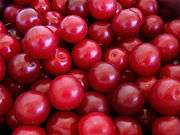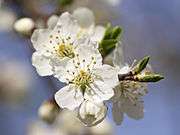Cherry plum
| Cherry plum | |
|---|---|
 | |
 | |
| Scientific classification | |
| Kingdom: | Plantae |
| (unranked): | Angiosperms |
| (unranked): | Eudicots |
| (unranked): | Rosids |
| Order: | Rosales |
| Family: | Rosaceae |
| Genus: | Prunus |
| Subgenus: | Prunus |
| Section: | Prunus |
| Species: | P. cerasifera |
| Binomial name | |
| Prunus cerasifera Ehrh. 1784 not Popov 1929 nor Lecoq & Lamotte 1848 | |
| Synonyms[1] | |
|
List
| |
Prunus cerasifera is a species of plum known by the common names cherry plum and myrobalan plum.[2] It is native to Europe[3][4] and Asia[2][5] and naturalized in scattered locations in North America.[6][7][8]
Wild types are large shrubs or small trees reaching 6–15 m (20–50 feet) tall, with deciduous leaves 4–6 cm (1.6–2.4 inches) long. It is one of the first European trees to flower in spring, often starting in mid-February. The flowers are white and about 2 cm (0.8 inches) across, with five petals. The fruit is a drupe, 2–3 cm in diameter, and yellow or red. It is edible, and reaches maturity from early July to mid-September.
Cultivated cherry plums can have fruits, foliage, and flowers in any of several colors. Some varieties have sweet fruits that can be eaten fresh, while others are sour and better for making jam.
Cherry plums are a key ingredient in Georgian cuisine where they are used to produce tkemali sauce, as well as a number of popular dishes, such as kharcho soup and chakapuli stew.
The cherry plum is a popular ornamental tree for garden and landscaping use, grown for its very early flowering. Numerous cultivars have been developed, many of them selected for purple foliage, such as 'Atropurpurea'.[9][10] These purple-foliage forms (often called purple-leaf plum), also have dark purple fruit, which make an attractive, intensely coloured jam. They can have white or pink flowers. The cultivar 'Thundercloud' has bright red foliage which darkens purple.[11] Others, such as 'Lindsayae', have green foliage. Some kinds of purple-leaf plums are used for bonsai[10] and other forms of living sculpture.
The variety 'Nigra' with black foliage and pink flowers, has gained the Royal Horticultural Society's Award of Garden Merit.[12]
The cherry plum has been listed as one of the 38 plants that are used to prepare Bach flower remedies,[13] a kind of alternative medicine promoted for its effect on health. However, according to Cancer Research UK, "there is no scientific evidence to prove that flower remedies can control, cure or prevent any type of disease, including cancer".[14]
| Images of cherry plums | ||||||
|---|---|---|---|---|---|---|
|
See also
References
- ↑ "The Plant List: A Working List of All Plant Species". Retrieved January 27, 2014.
- 1 2 UConn Horticulture Archived April 14, 2010, at the Wayback Machine.
- ↑ Altervista Flora Italiana, Prunus cerasifera Ehrh. includes photos and European distribution map
- ↑ "UC/JEPS: Jepson Manual treatment for Prunus cerasifera". berkeley.edu.
- ↑ Flora of China, Prunus cerasifera Ehrhart, 1789. 樱桃李 ying tao li
- ↑ Flora of North America, Prunus cerasifera Ehrhart, 1784. Cherry plum, myrobalan
- ↑ "University of Washingtion Herbarium Image Collection - Burke Museum". washington.edu.
- ↑ "Calflora taxon report, University of California: Prunus cerasifera". calflora.org.
- ↑ "Gardening". ncsu.edu.
- 1 2 Pissard Plum Fact Sheet
- ↑ Thundercloud Fact Sheet
- ↑ "RHS Plant Selector Prunus cerasifera 'Nigra' AGM / RHS Gardening". Apps.rhs.org.uk. Retrieved 2012-11-26.
- ↑ D. S. Vohra (1 June 2004). Bach Flower Remedies: A Comprehensive Study. B. Jain Publishers. p. 3. ISBN 978-81-7021-271-3. Retrieved 2 September 2013.
- ↑ "Flower remedies". Cancer Research UK. Retrieved September 2013. Check date values in:
|access-date=(help)
External links
| Wikimedia Commons has media related to Prunus cerasifera. |
- Prunus cerasifera in the CalPhotos Photo Database, University of California, Berkeley
- EUFORGEN species page on Prunus cerasifera. Information, genetic conservation units and related resources.


